TIBETAN ARCHITECTURE
1/48
There's no tags or description
Looks like no tags are added yet.
Name | Mastery | Learn | Test | Matching | Spaced |
|---|
No study sessions yet.
49 Terms
Tibet
Tibetan Bod, in full Tibet Autonomous Region, historic region and autonomous region of China that is often called “the roof of the world.”
It is derived from the Mongolian Thubet, Chinese Tufan, Tai Thibet and the Arabic Tubbat.
It occupies a vast area of plateaus and mountains in Central Asia, including Mount Everest.
Lhasa
The capital city of Tibet.
Rock or stones
Wood and Timber
Earth
Clay
Concrete
The local materials in Tibet are?
Dry
What is the climate in Tibet?
Buddhism
What is the religion in Tibet that became the dominant cultural form?
Incarnate Lama
The institution of Tulku
Dalai Lama
Who is the most famous lama?
Flat roofs with parapets
What type of roof is in central and western Tibetan plateau with seldom rain?
sloping golden roofs
What type of roofs are only used in palaces, monasteries, and pagodas, and are a symbol of respect, and political, and religious power in Tibet?
yak-headed totem
The windows looks like _____, which is a symbol of good luck in Tibetan culture.
Baka
What do you call the Tibetan-style windows which are framed black?
Red
It is a symbol of majesty and status in Tibetan culture.
It also represents the "god of the earth", which is the heritage of the ancient Bon religion.
In addition, it also represents the boundlessness of the Buddha's teachings, which are the most devout believers of the Tibetan people.
Black
It represents the "Underground God".
In Tibetan Buddhism, it is the color of the goddess of Dharma protection and can ward off evil spirits.
Yellow
A widely-used color. It s the color of the Gelugpa school and in Buddhism, it is the symbol of Manjushri Bodhisattva.
Lung-ta or Wind horse
A horse that is both the subduer of evil & the vehicle of enlightenment.
One roll of 25 flags strung together shows five traditional designs, every five times.
Darchor flags
This are rectangular cloth that hangs vertically, attached by its longest side to a pole.
It carry wishes of longevity, fortune, health, and money in the wind.
Gompas
Buddhist temples or monasteries common in the historical region of Tibet including parts of China, Nepal, India, Bhutan, and Ladakh.
A spiritual center where Buddhist ideas and beliefs are taught and where one leans to renounce their materialistic and sensual desires and cultivate the right attitude.
It has a Rectangular or Square in Plan which is a Central prayer hall furnished with a Buddha statue and benches that nuns or monks use to engage in prayers.
it provides Living accommodations and has Stupas or chortens.
Stupas or Chorten
A Tibetan Buddhist Shrine.
Style of Nepalese Architecture originating in ancient India and are Buddhist in their concept and execution, designed as a tomb-like structure to house sacred relics. The shape is a representative of Buddha, with the top of the spire symbolizing his crown, while his head is the square at the spire’s base and his body the hemispherical dome shape. His legs are represented by the four steps on the lower terrace at the base of his throne, while the four sides of the square base (harmika) are often painted with pairs of “all-seeing” eyes.
The design is also believed to represent the five Buddhist elements – Earth (the square base), Water (the hemispherical dome), Fire (the conical spire), Air (the upper lotus parasol), Space (the sun and the dissolving point).
Lotus Blossom
Enlightenment
Many Doors
Great Miracles
Descent from the God Realm
Reconciliation
Complete Victory
Nirvana
What are the 8 great Stupas?
Lotus Blossom Stupa or Stupa of Heaped Lotuses
The stupa represents the birth of Buddha.
It is said that at the time of his birth, he took seven steps in all four directions signifying love, joy, compassion, and equality.
This chorten generally has four circular steps at the base and is decorated with designs of lotus petals.
Enlightenment Stupa or Stupa of the Conquest of Mara
This stupa signifies the time when Buddha under the Bodhi tree in Bodh Gaya attained enlightenment. It is said that the demon Mara tried to tempt and attack him, but Buddha come out as the conqueror.
Stupa of Many Doors or Gates
Buddha then preached his teachings to his followers near Sarnath. The doors on this monument signify the opening of the doors to Dharma and point to the teachings:
Four Noble Truths
Noble Eightfold Path
Twelve Links in the Chain of Dependent Origination
Six Perfections
Stupa of Descent from the God Realm
When Buddha's mother was reincarnated in another realm, he went there to teach her Dharma. This chorten consists of a ladder on each side and commemorates the return of Buddha back to earth.
Stupa of Great Miracles or Stupa of the Conquest of Thirthikas
When Buddha was 50 years old, he performed various miracles to prove his spirituality and even overpowered several demons.
Stupa of Reconciliation
This octagonal chorten honors Buddha’s efforts in solving a conflict among his monastic followers. It was built in the kingdom of Magadha where the conflict resolution took place.
Stupa of Complete Victory
This chorten has only three circular steps which are undecorated. It honors Buddha’s extension of his life by three months when his followers pleaded with him to stay.
Stupa of Nirvana
The Nirvana chorten represents Buddha’s death and his achieving a state of true peace. This monument is undecorated and appears to be bell-shaped
Tashilhunpo Monastery
The largest monastery in Shigatse, the center of religion, politics, and culture in the Tsang region and the seat of Panchen Lama. Occupying an area of 150,000 square meters, the monastery is surrounded by 3000-meter-long wall. The whole monastery was constructed against the background of the mountain, facing the sun. There are 58 sutra chapels and about 3600 rooms.
Four Greatest Monasteries of Tibetan Gelugpa Sects
What are they referred to?
Sera Monastery
Ganden Monastery
Drepung Monastery
Tashilhunpo Monastery
Gendun Drup
He is the disciple of Tsongkhapa (founder of the Gelug sect) founded Tashi Lhunpo in 1447. He was later named the first Dalai Lama. His remains are enshrined within Tashi Lhunpo.
Panchen Lama
The Tashilhunpo monastery is the seat of _____, the second most important Lama in Tibet after the Dalai Lama.
Chapel of Jamba, Tashilhunpo Monastery
A five-story palace with two winding corridors below. It is a fieldstone-lined chapel with a height of 30 meters and an area of 862 square meters. In the chapel sits a gigantic statue of Maitreya, the future buddha. Based on the 3.8-meter-high lotus-shaped foundation, this statue is the largest and tallest bronze figure of Buddha in the world, 26.2meters high and 11.5 meters wide across the shoulder.
Statue of Maitreya, the future Buddha
This statue is the largest and tallest bronze figure of Buddha in the world, 26.2meters high and 11.5 meters wide across the shoulder.
Stupa of the tenth Panchen Lama, Tashilhunpo Monastery
Constructed the fifth to ninth Panchen Lamas’ multi-burial stupa under the support of the government after the destruction. The osseous remains of five Panchen Lamas are placed in the stupa Tashi Langyar and their accomplishments of them are painted on the surrounding walls.
It is the largest one which covers 253 square km. The body of the stupa reaches 11.55 meters.
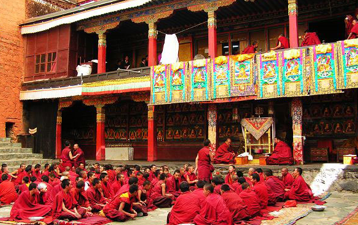
Tsochin Hall, Tashilhunpo Monastery
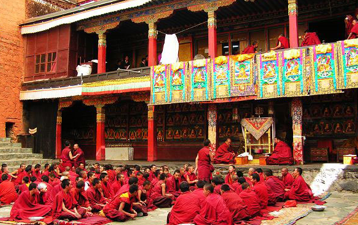

Kelsang Temple, Tashilhunpo Monastery
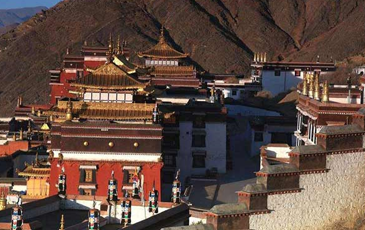
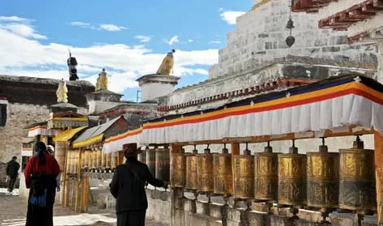
Kora Tashilhunpo Monastery
Tibetan word, “Skor ra”, which means “circumambulation” or “revolution”.
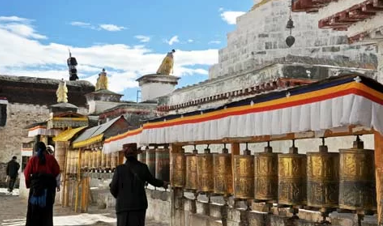
Jokhang Temple
Standing four stories tall, spread over an area of about 25,000 square meters in the heart of Lhasa, the UNESCO world Heritage temple with its golden roof is an esoteric blend of local Tibetan elements with Nepalese, Chinese, and Indian influences.
The spinning of prayer wheels, murmur of mantras, and humble prostrations of devout pilgrims all year long but especially at Losar during the Great Prayer Festival show the significance of this revered spiritual center of Tibet.
Its name means “House of Buddha”, which is the spiritual center of Tibet and is one of the holiest destinations for Buddhist pilgrims.
Songtsen Gampo
Jokhang Temple was first built in the 7th century when Tibet was ruled by a wise and able king called________ .
Princess Wencheng
The site of Jokhang Temple was chosen by the wife of the late king, who is from the Tang Dynasty in Central China.
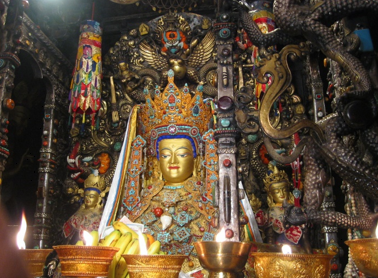
Jowo Shakyamuni, Jokhang Temple or Jowo Rinpoche
The holiest object in Tibet.
It is made of gilt metal—the effect is an image of a gold hue with shocking blue hair.
It seated with his legs in the lotus position or padmasana. His left hand is in the mudra (hand gesture) of meditation (dhyana mudra) and his right hand is in the gesture of “calling the earth to witness” (bhumisparsha mudra).
Together, these postures signify the moment of the Buddha’s enlightenment. He is shown wearing a thin monk’s robe, which drapes over his body and covers his left shoulder. When dressed, the statue is presented with a magnificent jeweled crown and robes.
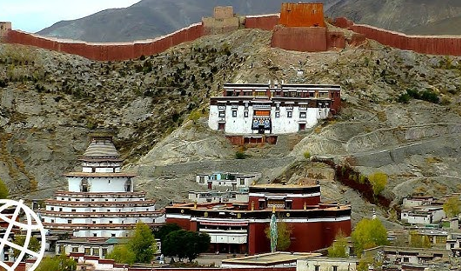
Palcho Monastery
The main monastery in Gyantse and ringed by mountains on its three sides.
In 1436, Pelkhor-tsen (the prince of Gyantse) and Gendun Drup (recognized as the first Dalai Lama) began to build Palcho Monastery and it cost if 10 years to accomplish it.
There is a nice coherent title of monastery and stupa because you can see stupa in the monastery and monastery in the stupa. It is the unique monastery where Gelugpa, Sakypa and Kadampa coexist, and you can get a fuller understanding of Tibetan Buddhist culture.
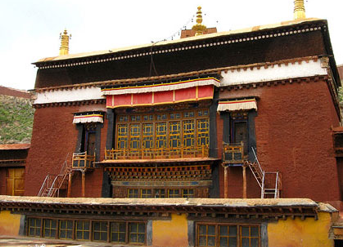
Tsulakalakang Temple, Palcho Monastery
As you enter Palcho Monastery, the construction straightly ahead you is this temple which is highlighted by the Assembly Hall or known as Cochin.
The entrance of Tsochin is decorated with lively statues of Four Guardian Kings, rather than ordinary paintings.
Tsochen has three floors. The first floor is supported by 48 columns with many ancient Thangkas hanging on.
On the left wall on the northwest side stood a gilded bronze eight-meter statue of Jamba which is made of 14,000 kg of brass.
Three Buddhas (Past Buddha, Current Buddha, and Future Buddha) are enshrined in the north chapel.
Cochin
It is known as the Assembly Hall
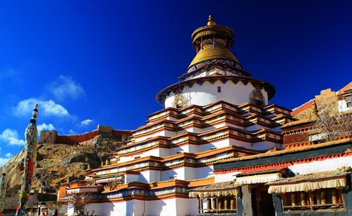
Gyantse Kumbum, Palcho Monastery
Standing 32 meters from the ground, and is the tallest stupa in Tibet and the only stupa of its kind in the Tibetan areas.
Nine tiers, each of which has its unique chapels, the stupa represents the “progressive hierarchy of a three-dimensional Mandala”
It has 78 chapels and 108 gates, niches, and stupa halls
The stupa base has 5 tiers in an octagonal shape.
The stupa body is shaped like a bottle tower – the higher, the smaller.
All lintels are ornamented with beautiful relieves like elephants, lions, and dragons.
There are thousands of images and statues of all Buddha, so stepping into it is like passing into the Buddhist Kingdom. There are exclusive chapels for the leaders of the Bon Sect, Mongolian Lamaism, White Sect, Yellow Sect, and some other renowned Lamas.
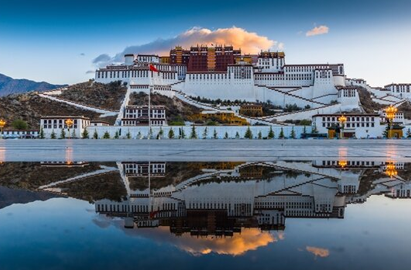
Potala Palace
It is an immensely religious and administrative complex in Lhasa, southern Tibet Autonomous Region, southwestern China. It is situated atop Mar-po-ri (Red Mountain), 425 feet (130 meters) above the Lhasa River valley and rises dramatically from its rocky base.
It contains 1,000 rooms including assembly halls, government offices, and temples, 10,000 altars, and 200,000 statues. Constructed of wood, stones, and mud bricks and fastened together without steel or nails, it covers an area of 41 hectares and is 13 stories high. The roofs are covered with gilded bronze tiles that glitter in the sun and can be seen miles away.
It symbolizes Tibetan Buddhism and its central role in the traditional administration of Tibet.
Potala
It is a translation of the Sanskrit "Putuoluo" which means "a famous scenic spot of Buddhism".
Potrang Karpo
Completed in1648 known as the White palace, which once served as the seat of the Tibetan government and the main residence of the Dalai Lama; from the mid-18th century, it was used as a winter palace.
Potrang Marpo
Completed in 1694 and known as the Red Palace, houses several chapels, sacred statues, and the tombs of eight Dalai Lamas; it remains a major pilgrimage site for Tibetan Buddhists.